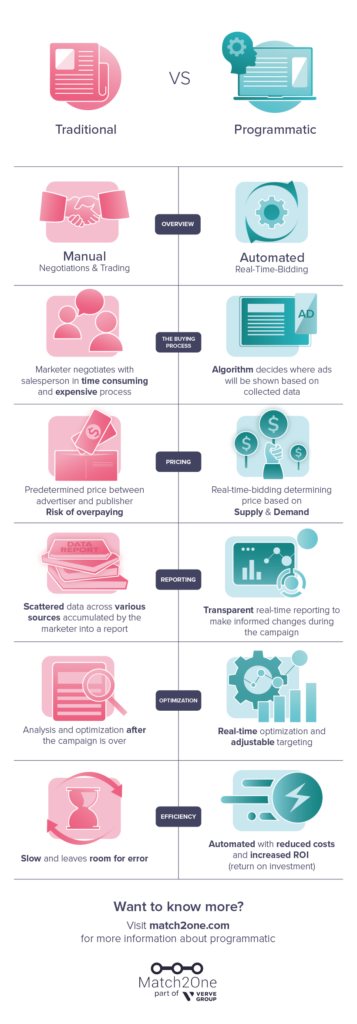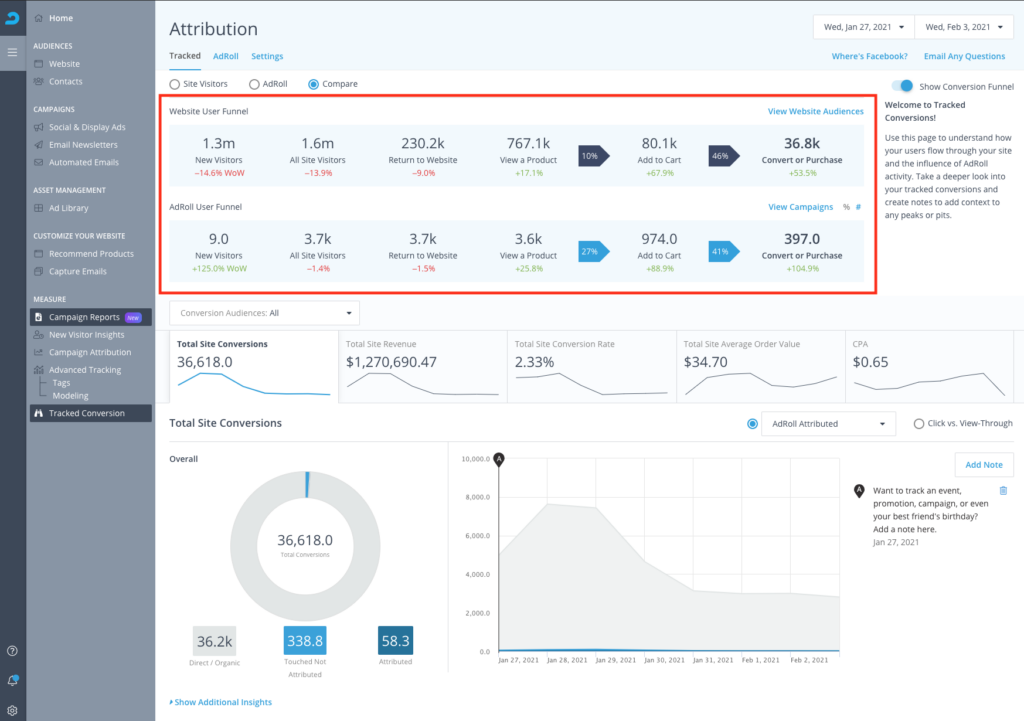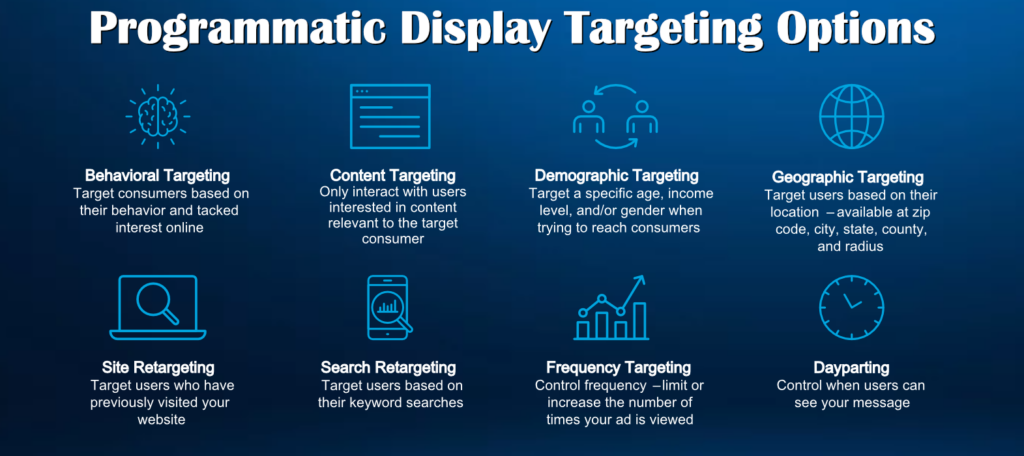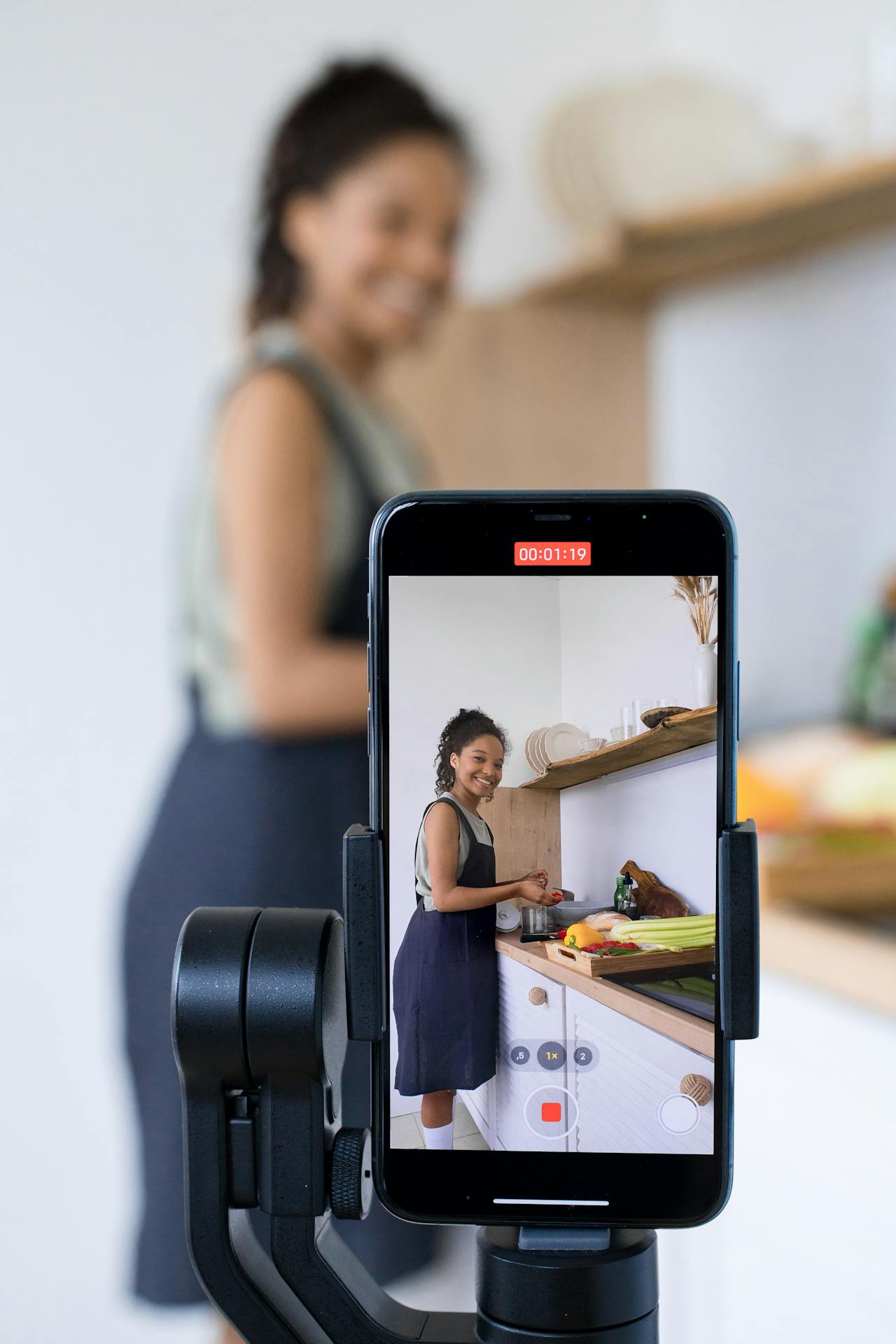Programmatic advertising accounts for as much as 90% of total ad spend globally. Last year, programmatic advertisements of $546 billion worth were sold globally which is expected to reach $779 billion by 2028. It is the future of online advertising.
This article serves as a guidebook for businesses, brands, advertisers, and marketers who are new to programmatic advertising and don’t know how and where to start.
What is Programmatic Advertising?
It refers to automated and data-driven online advertising. The term ‘programmatic’ means the process of buying and selling ad space is fully automated and relies on artificial intelligence, algorithms, and data. Your ads are served automatically at the right place to the right audience without you having to check or approve all the placement (and targeting) options.
Here’s an example of a programmatic ad campaign by Amanda Foundation. The audience sees ads that are relevant to them and this resulted in a highly relevant campaign where the right pet was matched to the right person:

The campaign was quite successful and got featured in the leading press. All the pets in the campaign were matched to the right owner.
Here’s how programmatic ads differ from traditional advertising:

Most of the ads you see or run today are programmatic. For example, when you run a YouTube ad campaign, you buy placement automatically based on the targeting options you have selected. But in this case, the ad inventory is only limited to YouTube and you don’t use a DSP to connect with an ad exchange.
Programmatic vs. Display Advertising
Most marketers confuse and compare programmatic ads with display advertising. These are two different terminologies that serve different purposes.
Programmatic advertising is the process of how ads are purchased and placed online. This includes all types of ad formats including display ads.
Display advertising is an ad format that’s most famous with Google Ads. These ads are shown to the target audience on websites and apps in different formats. Display ads are programmatic as bids and placement take place automatically based on a set criterion and budget.
Programmatic ads can be display ads and vice versa.
Essentially, programmatic advertising is the process of ad placement, bidding, and targeting and this has nothing to do with display ads which is one of the many ad formats that are part of traditional and programmatic advertising.
Benefits of Programmatic Advertising
Here are the core benefits of using programmatic advertising for your business that make it better than other forms of marketing and advertising:
- Automation: The best thing about programmatic advertising is that it is fully automated with minimal or no manual intervention or supervision.
- Quick setup: It takes a few minutes to set up a programmatic ad campaign. This feature isn’t available with non-programmatic ads where you have to wait for days to get approval and then your campaign is scheduled.
- Targeting: Programmatic ads use data, machine learning, and advanced algorithms to serve your ads to the right audience that’s most likely to interact with your ad. This significantly improves the targeting and reach of your ads.
- Advanced reporting: As an advertiser, you know where your ads are served, the demographics of the audience, the cost per click or impression, and other details. You get granular reporting with access to everything including tracking.
- Reduced cost: The cost of programmatic ads is quite low as you only pay for valid clicks and impressions. Depending on the type of campaign you have set up, you can optimize your spending and choose to pay only for conversions or sales. In any case, you don’t pay for fraudulent and invalid ad activity.
- High ROAS: Low cost and improved efficiency of programmatic ads lead to a high ROI and ROAS. Your ads are served at the placements where they are more likely to perform better which means your campaigns are auto-optimized leading to better ROAS. This is achieved by AI and algorithms that constantly monitor ad performance and evolve.
How Programmatic Advertising Works
The process involves multiple entities and a few terminologies that are essential to understand how it works. The key entities and terms are:
- Advertiser: Businesses that want to buy ads to reach their target audience
- Publisher: People who own websites where they sell ad space
- Ad exchange: It is a platform that connects advertisers with publishers
- Demand side platform (DSP): A DSP is a platform that advertisers use to buy ad space (known as ad inventory) from several ad exchanges
- Supply side platform (SSP): It is a platform that’s used by publishers to list and sell available ad spaces via ad exchanges
- Real-time bidding (RTB): The process of buying and selling online ads in real-time via an ad exchange.
Let’s see how the process works through these platforms:
- The advertiser contacts the DSP to buy ad space based on specific needs.
- DSPs work with ad exchanges in real-time to buy ads based on advertiser needs
- The DSP initiates an ad request when a person lands on a publisher’s website (who meets the advertiser criterion). The ad request is sent to the SSP via an ad exchange
- The DSP evaluates the price and other parameters that it receives from the SSP and then decides to furnish the ad if it meets the criterion (e.g., price, targeting, etc.,)
- This exchange of ad space between a DSP and SSP (on behalf of their customers) takes place in real-time in milliseconds.
This entire process takes less than a second and is repeated several times across websites simultaneously. For example, a website that has 100 visitors at a given moment might receive 100 or more requests from DSPs and will furnish all ad requests simultaneously in no time.

The process might seem complicated or technical, but it isn’t. Advertisers use a dashboard to create and manage ad campaigns while suppliers list ad space through a nice, intuitive dashboard from their SSPs.
AdRoll, for example, is a popular DSP, and here’s what its dashboard looks like:

Nothing technical or complicated here, and it goes for all DSPs and SSPs. Advertisers only have to set up their campaigns and that’s it. The backend process is managed automatically by the DSP platform.
Types of Programmatic Advertising
There are multiple ways to use programmatic ads to reach your target audience:

Real-time bidding (RTB): Also known as open marketplaces which is the most common type of programmatic advertising. It uses online auctions in real-time where advertisers bid on available ad space and the highest bidder gets the spot. This all happens at the backend in real-time in milliseconds on full automation (as discussed above).
Private marketplaces: Unlike open marketplaces, private ones are invite-only where publishers invite and/or allow a limited number of advertisers to buy ad space. Private marketplaces have the same working mechanism with the only difference being that they aren’t open for all types of advertisers.
Preferred deals: Publishers offer premium ad inventory to selected advertisers at a fixed cost. These premium ad positions and spaces are given preference over other placement options and thus have more value.
Programmatic direct: Also known as programmatic guaranteed. Advertisers and publishers agree to a fixed number of impressions or clicks (guaranteed) for a fixed price. It doesn’t involve an auction, rather it is a manually negotiated deal.
Steps to Get Started with Programmatic Advertising
If you are interested in running a programmatic ad campaign for your business, follow these steps to get started:
1. Set Advertising Goals
The first step is setting goals for your advertising strategy. The most common goal type is conversion where you send traffic to a landing page and generate a lead or sale.
The most common goal types for online advertising strategy include:
- Brand awareness
- Engagement
- Traffic generation
- Lead generation
- Sales.
You need to set a strategy-level goal for programmatic advertising and it should have the following elements:
- It must be a formal, written goal
- Have timeline
- Alignment with overall marketing strategy.
I recommend using the SMART goal technique to create a well-defined goal. Here’s what a SMART goal means:

Setting a clear goal helps you allocate budget and resources. It also helps you measure performance easily by using the right metrics. When you don’t have a clear goal defined for an ad campaign, it gets challenging to measure performance.
For example, if your goal is to generate 100 leads through programmatic advertising in a month, you’ll be able to measure the performance easily by calculating the number of leads.
Setting a goal also involves identifying the right buyer persona to target. It is best to choose one buyer persona per ad campaign to keep tracking simplified.
2. Choose DSP
Once you know what exactly you want to achieve with programmatic advertising, you are all set to choose your demand side platform (DSP).
Making the right choice is crucial for success as ad inventory quality, pricing, features, and other services all depend on the DSP you work with.
Here is a list of the major factors to consider when choosing a DSP:
Reach
Not all DSPs have equal reach. Some have limited reach as they work with fewer SSPs. Ideally, you should look for a DSP that has a massive reach and it offers all types of publishers. This information is critical because if you end up working with a DSP that works with an unknown ad exchange and SSP, your ads will reach a much smaller market.
Unfortunately, it’s not as straightforward to empirically measure a DSPs actual reach. You have to take their word.
Targeting
The DSP should offer wide targeting options. If it is only limited to basic demographics, you should avoid it. The efficacy and ROI of your programmatic ad campaign depend on targeting. Choose a DSP that allows behavioral, geo-contextual, content, retargeting, predictive, and other types of advanced targeting features.

Ad formats
Look for a DSP that offers multiple ad formats. The leading ad formats for programmatic ads are display, video, native, audio, interactive media, interstitial, and sticky. You might not need all these ad formats now, but you’ll eventually have to try all of them in the future because advertising is all about experimentation.
You need to find the ad format that converts best for your target audience and that’s where ad format variety comes into play. If the DSP has limited ad formats, you won’t have much room for experimentation and you might feel your hand tied.
Integration
App silos are a massive issue for businesses. Apps that work as standalone and don’t integrate with the rest of your tech stack cause data management issues that reduce revenue by 30% annually.
The DSP should integrate with existing tools that your business is using, especially with the data management platform, customer data tools, CRM, marketing apps, tracking and analytics software, and sales funnel. If it doesn’t integrate with the rest of the tech stack, it will make DSP ineffective and you’ll struggle with data management.
Give due importance to integration.
Price
A DSP can turn out to be too expensive if you choose the wrong one. Most DSPs charge you a monthly fee and some of them charge you setup and maintenance fees. If you choose managed service, it will cost you way too much per month.
Here’s what you need to do to find the right-priced DSP:
- Look for DSPs that don’t charge a subscription fee
- Choose a DSP that has no minimum spend
- Go for self-service DSPs as you don’t have to pay management fees.
Finding the right mix of price and features is tough, but you can do it if you don’t haste. Take your time and spend a few weeks on market research.
Bidding strategy
Choose a DSP that offers multiple bidding strategies. It gives you more control over spending and budget optimization. The common bidding strategies include CPC, CPM, CPA, and CPL. You should avoid DSPs that only offer CPC and CPM strategies.
Bid optimization, automated bidding, and dynamic creative optimization are a few additional bidding features that help you improve the ROAS of your programmatic ad campaigns. Look for these bidding options in the DSP.
Fraud prevention
Fraudulent ad clicks is one of the biggest challenges that advertisers face. Over $88 billion was lost by advertisers in ad fraud in 2023 which is expected to reach $172 billion by 2028. Research shows that 22% of all online ad spend and 30% of mobile ad spend was lost due to ad fraud in 2023.

The DSP you choose should have built-in features to detect ad and click fraud. It should offer features like IP blacklisting, reporting ad fraud, and it should work with third-party click fraud prevention tools. If your DSP doesn’t have a robust ad fraud prevention system, you’ll end up paying a lot more per click. Avoid such DSPs.
Ease of use
Most DSPs are easy to use and offer a clean and intuitive user interface. This doesn’t mean there isn’t any learning curve. Choose a DSP that has a minimal learning curve.
As your business grows, you’ll have to give access to more employees to the DSP. For complicated interfaces, you’ll end up paying a lot in training fees. Most businesses ignore this cost.
Choosing an easy-to-use DSP can save you a lot of money in the long run.
Analytics
The DSP should offer detailed tracking and analytics. Real-time analytics is a must as it helps you take appropriate actions on time.
Real-time analytics help you make necessary tweaks quickly to your ad campaigns. You can reduce the budget for underperforming ads and boost bids and budget for ads that outperform. Additionally, analytics is the backbone of programmatic ads as it helps you in decision-making and experimentation.
Customer support
How quickly you get a response from the DSP on critical issues and how effective they are in resolving major problems that you face are the two major deciding factors.
Proactive customer support isn’t enough. You need to make sure that the DSP you choose has the potential to resolve your issues quickly. This is possible when you get access to the relevant technical teams right away – instead of support agents.
Poor customer support from the DSP might cost you some big bucks. Choose wisely.
3. Setup Your Campaign
After you have selected a DSP, you are all set to create your first programmatic ad campaign.
The exact process to create an ad campaign varies from DSP to DSP. You’ll need to go through help articles or an onboarding sequence to set up your account and first ad campaign.
The process is, usually, straightforward and doesn’t require a lot of time.
Think of creating an ad campaign with Google Ads or Meta Ads which hardly take 5 minutes to set up once you have the creatives ready. DSPs have similar interfaces and are easy to get started.
If your DSP has given you a demo account or trial access, make sure you use it effectively to explore different functions of the DSP. You should have creatives ready before signing up for a free trial or demo account with a DSP so you can get started immediately and get the most from your trial period.
Here’s a list of things you need to create a programmatic ad campaign:
- Buyer persona details
- Targeting details
- Ad creatives
- Budget
- Attribution model
- Tracking tool.
Ad creatives take the most time as you can only develop creatives once you have signed up for the DSP and you have exact details about ad formats and creative details. Try having the basic layout ready upfront. You can adjust it according to the DSP requirements.
4. Track Performance
Programmatic ads, like other digital ads, require regular monitoring. You have to check reports daily and do two things:
- Fix issues such as overspending or low ad performance
- Optimize campaigns, especially ads that are and aren’t doing well.
Most advertisers don’t touch ads that perform well, and that’s a flawed approach. You need to tweak your best performing ad to make it better. You never know its full potential unless you tweak it.
Track, tweak, and experiment with both underperforming and overperforming programmatic ad campaigns. Run A/B tests to constantly move to the better ad version.
Top DSPs to Choose From
Here’s a list of the popular DSPs to help you get started right away:
- Amazon DSP: It supports display, video, and audio ad formats with multiple targeting options including behavioral, contextual, and retargeting.
- Display & Video 360: It is Google’s DSP platform that offers display, video, audio, DOOH, and TV ad formats with tons of targeting options. The best thing is that it is available across the globe.
- The Trade Desk: You get display, mobile, native, in-app, video, and audio ad formats with behavioral and geo as main targeting options. It is currently available in a few countries including the US and UK.
- Criteo: It offers a wide range of ad formats including audio, video, display, CTV, tablet, native, in-app, and several others. The targeting options aren’t as advanced as you get with some of the other DSPs. It offers geo, device type, IP, and a few other ways to target your audience.
- Adobe Advertising Cloud: Search, CTV, DOOH, native, display, audio, and video are the available ad formats. You can target an audience using geo, connectivity, device, and others. It lacks behavioral and demographic targeting which is a major downside. It is available across the globe with minimal restrictions.
Final Words
Programmatic advertising can supercharge your online advertising and marketing efforts. If you haven’t used programmatic ads to reach your target audience, this is the right time to step in.
Getting started is a quick and smooth process. The only hurdle is finding the right DSP. Once you have connected with a reliable DSP, things get easier and your ad campaigns will run on autopilot with minimal (but necessary) supervision.
Featured Image: Pexels



